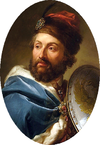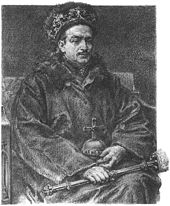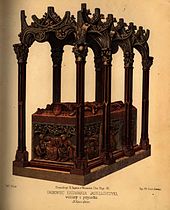Casimir IV Jagiellon
- Birth Date:
- 30.11.1427
- Death date:
- 07.06.1492
- Extra names:
- Kasimir IV. Jagiełło, Kazimirs IV Jagello, Kazimirs IV Jagellončiks, Kazimirs IV Jagelonietis, Kazimirs IV Jagailietis, Kazimierz IV Jagiellończyk, (arī Kazimirs IV Jagellončiks, Kazimirs IV Jagailietis) (poļu:Kazimierz IV Jagiellończyk), Lietuvas
- Nationality:
- lithuanian, pole
- Cemetery:
- Kraków, katedra na Wawelu
Casimir IV KG (Polish: Kazimierz IV Jagiellończyk [kaˈʑimi̯ɛʒ jaɡi̯ɛlˈlɔɲt͡ʃɨk] Lithuanian: Kazimieras IV Jogailaitis; 30 November 1427 – 7 June 1492) of the House of Jagiellon was Grand Duke of Lithuania from 1440, and King of Poland from 1447, until his death.
Casimir was the second son of King Władysław II Jagiełło (Jogaila), and the younger brother of Władysław III of Varna.
Grand Duke of Lithuania


The sudden death of Sigismund Kęstutaitis left the office of the Grand Duchy of Lithuania empty. The Voivode of Trakai, Jonas Goštautas, and other magnates of Lithuania, supported Casimir as a candidate to the throne. However many Polish noblemen hoped that the thirteen-year-old boy would become a Vice-regent for the Polish King in Lithuania. Casimir was invited by the Lithuanian magnates to Lithuania, and when he arrived in Vilnius in 1440, he was proclaimed as the Grand Duke of Lithuania on 29 June 1440 by the Council of Lords, contrary to the wishes of the Polish noble lords—an act supported and coordinated by Jonas Goštautas. This act could have been understood as dissolution of the personal union between the Grand Duchy of Lithuania and the Kingdom of Poland. When the news arrived in the Kingdom of Poland concerning the proclamation of Casimir as the Grand Duke of Lithuania, it was met with hostility, even to the point of military threats against Lithuania. Since the young Grand Duke was underage, the supreme control over the Grand Duchy of Lithuania was in the hands of the Council of Lords, presided by Jonas Goštautas. Casimir had been taught the language and customs of Lithuania by appointed court officials.
During Casimir's rule the rights of the Lithuanian nobility—dukes, magnates and boyars (lesser nobles), irrespective of their religion and ethnicity—were put on an equal footing to those of the Polish szlachta. Additionally, Casimir promised to protect the Grand Duchy's borders and not to appoint persons from the Polish Kingdom to the offices of the Grand Duchy. He accepted that decisions on matters concerning the Grand Duchy would not be made without the Council of Lords' consent. He also granted the subject region of Samogitia the right to elect its own elder. Casimir was the first ruler of Lithuania baptised at birth, becoming the first native Roman Catholic Grand Duke.
King of Poland

Casimir succeeded his brother Władysław III (killed at the Battle of Varna in 1444) as King of Poland after a three-year interregnum on 25 June 1447. In 1454, he married Elisabeth of Austria, daughter of the late King of the Romans Albert II of Habsburg by his late wife Elisabeth of Bohemia. Her distant relative Frederick of Habsburg became Holy Roman Emperor and reigned as Frederick III until after Casimir's own death. The marriage strengthened the ties between the house of Jagiello and the sovereigns of Hungary-Bohemia and put Casimir at odds with the Holy Roman Emperor through internal Habsburg rivalry.
That same year, Casimir was approached by the Prussian Confederation for aid against the Teutonic Order, which he promised, by making the separatist Prussian regions a protectorate of the Polish Kingdom. However, when the insurgent cities of the Teutonic Monastic State of Prussia rebelled against the Order, it resisted with greater strength than expected, and the Thirteen Years' War (1454–1466) ensued. Casimir and the Prussian Confederation defeated the Teutonic Order, taking over its capital at Marienburg (Malbork Castle). In the Second Peace of Thorn (1466), the Order recognized Polish sovereignty over the seceded western Prussian regions, therefore then called Royal Prussia, and the Polish crown's overlordship over the remaining Teutonic Monastic State of Prussia, transformed in 1525 into a duchy, thus consistently called Ducal Prussia.
Elisabeth's only brother Ladislas, king of Bohemia and Hungary, died in 1457, and after that Casimir and Elisabeth's dynastic interests were directed also towards her brother's former kingdoms.
Children
- Hedwig Jagiellon married George the Rich, of the Wittelsbach dynasty of Bavaria. Delegates had gone to Kraków to negotiate the marriage, and their "Landshut Wedding" took place in Bavaria with much pomp and celebration in 1475, starting a tradition which continues to this day.
- Saint Casimir was to have married the daughter of Emperor Frederick III, but instead chose a religious life, eventually being canonized as St. Casimir.
- Vladislaus II of Bohemia and Hungary combined the thrones of Hungary and Bohemia.
- Sophie, married to Margrave Frederick V of Brandenburg-Ansbach
- John I of Poland (27 December 1459 – 17 June 1501) succeeded him as the king of Poland (1492–1501)
- Alexander Jagiellon (5 August 1461 – 19 August 1506) King of Poland (12 December 1501 – 19 August 1506)
- Sigismund I the Old (1 January 1467 – 1 April 1548) King of Poland (1506 - 1548)
- Friedrick Jagiellon (April 27, 1468 – March 14, 1503) Archbishop of Gniezno, Bishop of Kraków, and Primate of Poland.
- Anna married to Duke Bogislaw X of Pomerania; they had eight children, including Sophie of Pomerania, who became queen of Denmark
- Barbara married to Duke Georg dem Bärtigen of Saxony
- Elizabeth Jagiellon (November 13, 1482 - February 16, 1517) who married Frederick II of Legnica
- Two additional daughters named Elizabeth.
Source: wikipedia.org
No places

| Relation name | Relation type | Description | ||
|---|---|---|---|---|
| 1 |  | Sofija Ketlere | Descendant | |
| 2 |  | Władysław II Jagiełło | Father | |
| 3 |  | Jadviga Polijas karaliene | Mother | |
| 4 |  | Сигизмунд I Старый | Son | |
| 5 |  | Vladislavs II Jagello | Son | |
| 6 |  | Jans I Olbrahts Jagello | Son | |
| 7 |  | Sophia Jagiellon of Poland | Daughter | |
| 8 |  | Vytautas | Uncle | |
| 9 |  | Lengvenis | Uncle | |
| 10 |  | Kaributas | Uncle | |
| 11 |  | Bona Sforza | Daughter in-law | |
| 12 |  | Algirdas | Grandfather | |
| 13 |  | Sigismund II Augustus | Grandson | |
| 14 |  | Vilhelms no Brandenburgas | Grandson | |
| 15 |  | Albert of Prussia | Grandson | |
| 16 |  | Anna Jagiellon | Granddaughter | |
| 17 |  | Isabella Jagiellon | Granddaughter | |
| 18 |  | Sophia Jagiellon of Poland | Granddaughter | |
| 19 |  | Catherine Jagellon | Granddaughter | |
| 20 |  | Ģedimins | Great grandfather | |
| 21 |  | Sigismund III Vasa | Great grandson | |
| 22 |  | Sigismund Korybut | Cousin | |
| 23 |  | Lee Konitz | Coworker | |
| 24 |  | Yuriy Drohobych | Employee |
05.02.1494 | 1494 – W Moskwie został podpisany traktat pokojowy kończący wojnę litewsko-moskiewską
Wojna litewsko-moskiewska 1492-1494 – stoczona w latach 1492-1494 pomiędzy Wielkim Księstwem Litewskim i Wielkim Księstwem Moskiewskim.




